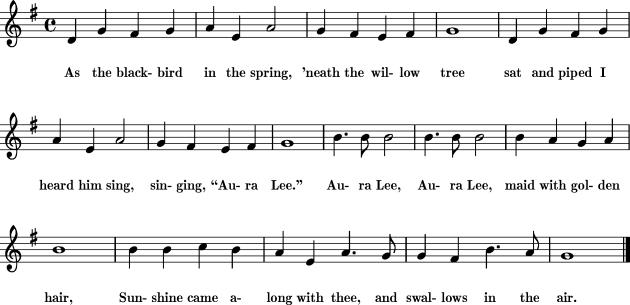The Central Role of Musical Repertoire
As already mentioned above, all music teaching, musicianship training and solfège education should be based on a suitable choice of musical repertoire: children songs, folksongs, art songs, canons, partsongs, instrumental music, etc. Of course different musical styles can be involved, reaching from classical and contemporary music to jazz and pop music. Some melodies in popular music are actually coming from traditional songs, like Elvis Presley’s ‘Love me tender’ which has the same melody as ‘Aura Lee’, a song composed by Poulton/Fosdick published in 1861[1]:
This song is still sung today, so for more than 150 years. The fact that it was adapted by Elvis Presley made it popular again and the melody can now be considered as belonging to the traditional American song repertoire. But why could this song be used in music teaching? For what purpose could we sing it with students? What musical elements in the song could be interesting for teaching purposes?
First a musical analysis is necessary which delivers central musical characteristics that could be experienced and made conscious using the song for active music listening and awareness. One of the most important musical elements is the fourth in the second bar: rl,r, escpecially because of the jump into the l, from the r and back to the r. Also the fourth s,d is typical, especially because it is not an upbeat. Concerning form we could analyze the melody as aaba’ or perhaps aabc. On a larger scale there is also a melodic development concerning Sekundgang. In the a-part, an ascending line s,l,t,d can be followed. At the same time de d moves up to r and back to d. Because of the repetition of the a part the expectation is created that the melody would raise further up to m, which is then happening in the b-part, where the m is very prominent. In the a’-part the melody turns down from the m after turning to its upper leading tone f which actually initiates the descending of the melody. By repeating the characteristic rl,r-gesture a second – ascending – line l,t,d is set up. Another fourth t,m gives an extra surprise before the melody finally ‘lands’ on the tonic d. Also the quote of the dotted rhythm from the b-part just before the end gives the melody musical congruence. The different melodic layers of Sekundgang on the one hand and the characteristic fourth turns on the other hand make this melody so typical and of high musical quality. Concerning rhythm, there is the rhythm pattern ta-adi-ta-a:
So this song is ideal for teaching that particular rhythm pattern as mentioned above. For integrating the song in solfa-teaching it is particularly interesting that the b-part consists of only three tones: drm. So for practizing solfa this section could be taken out to aurally recognize this particular toneset. At the same time there is a melodic passage from m to d and back, so r as as passing tone can be practized.
Thus singing this song with students forms actually a preparation for further musical learning. This is the reason why choice of repertoire is a central concern of the music teacher. The students, while enjoying singing, moving and performing, are actually unconsciously learning musical elements which they can become aurally aware of in the further musical learning process. It is then also the responsibility of the teacher to present these musical elements in a later stage, after the song is known so well that the students are actually ‘owning’ the song. These elements can then be connected to written symbols, graphical representations such as staff notation. Another important ingredient of music teaching is to repeat what has been learnt and apply it to other musical contexts. So a lot of practice is necessary to turn all this into the development of musical skills to evoke deeper musical understanding. Activities such as inventing rhythms and melodies, vocal improvisation, recomposing and composition are indispensable for this. How ever important the role of the teacher might be in creating curriculum, organizing learning strands and step-by-step teaching strategies, it is of course important that there is also freedom for the individual student to learn to use musical skills in a creative way. For example, inventing expressive movement to a sounding piece of music or improvising melodies on a given toneset are necessary practice activities.
The triptych of Preparation-Presentation-Practice, the so-called PPP-approach can be seen as the core of the Kodály-inspired music lessons. There is a strong accent on the preparation, because by that the active musical performance is happening. The preparation is the fundament for further musical learning. This is one of the reasons why I consider the Kodály-approach such a strong way of teaching and learning music. By this approach, musical performance of repertoire forms the fundament. And by this everyone being involved in the education proces is addressed as a musician: student and teacher.
Concerning single musicianship, solfège or other music lessons the three P’s should always be involved. In one lesson we practize what we have learned in the lesson before. And in the same lesson we already prepare for further learning in the following lesson. We only present a musical element of certain repertoire which we have fundamentally prepared pracically in the lessons before. So the congruence between the lessons lead to a continuous development of musical learning. On a larger scale musical curriculum, the long-term planning, comes into the picture. The mentioned tools are not a goal on their own, they are – tools. The higher musical goal is to open up the musical world for every musical learner and to make music as an art form in all its variety accessible to anyone.

